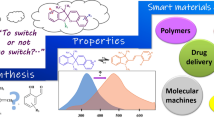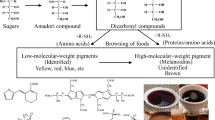Abstract
In non-viscous aqueous solutions, the cyanine fluorescent dyes Cy3 and Cy5 have rather low fluorescence efficiency (the fluorescence quantum yields of Cy3 and Cy5 are 0.04 and 0.3, respectively [1, 2]) and short excited state lifetimes due to their structural features. In this work, we investigated the effect of solubility and rotational degrees of freedom on the fluorescence efficiency of Cy3 and Cy5 in several ways. We compared the fluorescence efficiencies of two cyanine dyes sCy3 and sCy5 with the introduction of a sulfonyl substituent in the aromatic ring as well as covalently bound to T10 oligonucleotides. The results show that because of the different lengths of the polymethine chains between the aromatic rings of the dyes, cis–trans-isomerization has a much greater effect on the Cy3 molecule than on the Cy5 molecule, while the effect of aggregation is also significant.








Similar content being viewed by others
Availability of Data and Materials
Not applicable.
References
Cooper M, Ebner A, Briggs M, Burrows M, Gardner N, Richardson R, West R (2004) Cy3B™: improving the performance of cyanine dyes. J Fluoresc 14:145–150. https://doi.org/10.1023/b:jofl.0000016286.62641.59
Wong KL, Bünzli JCG, Tanner PA (2020) Quantum yield and brightness. J Lumin 224:117256. https://doi.org/10.1016/j.jlumin.2020.117256
Stennett EMS, Ciuba MA, Lin S, Levitus M (2015) Demystifying PIFE: The Photophysics Behind the Protein-Induced Fluorescence Enhancement Phenomenon in Cy3. J Phys Chem Lett 6(10):1819–1823. https://doi.org/10.1021/acs.jpclett.5b00613
Rashid F, Raducanu V-S, Zaher MS, Tehseen M, Habuchi S, Hamdan SM (2019) Initial state of DNA-Dye complex sets the stage for protein induced fluorescence modulation. Nat Commun 10(1):2104. https://doi.org/10.1038/s41467-019-10137-9
Jares-Erijman EA, Jovin TM (1996) Determination of DNA Helical Handedness by Fluorescence Resonance Energy Transfer. J Mol Biol 257(3):597–617. https://doi.org/10.1006/jmbi.1996.0188
Li X, Yin Y, Yang X, Zhi Z, Zhao XS (2011) Temperature dependence of interaction between double stranded DNA and Cy3 or Cy5. Chem Phys Lett 513(4–6):271–275. https://doi.org/10.1016/j.cplett.2011.08.017
Kurutos A, Ryzhova O, Trusova V, Gorbenko G, Gadjev N, Deligeorgiev T (2016) Symmetric meso-chloro-substituted pentamethine cyanine dyes containing benzothiazolyl/benzoselenazolyl chromophores novel synthetic approach and studies on photophysical properties upon interaction with bio-objects. J Fluoresc 26:177–187. https://doi.org/10.1007/s10895-015-1700-4
Yarmoluk SM, Kovalska VB, Losytskyy M (2008) Symmetric cyanine dyes for detecting nucleic acids. Biotech Histochem 83(3–4):131–145. https://doi.org/10.1080/10520290802383684
Kurutos A, Orehovec I, Paić AT, Crnolatac I, Horvat L, Gadjev N, Deligeorgiev T (2018) New series of non-toxic DNA intercalators, mitochondria targeting fluorescent dyes. Dyes Pigm 148:452–459. https://doi.org/10.1016/j.dyepig.2017.09.049
Kurutos A, Orehovec I, Saftić D, Horvat L, Crnolatac I, Piantanida I, Deligeorgiev T (2018) Cell penetrating, mitochondria targeting multiply charged DABCO-cyanine dyes. Dyes Pigm 158:517–525. https://doi.org/10.1016/j.dyepig.2018.05.035
Constantin TP, Silva GL, Robertson KL, Hamilton TP, Fague K, Waggoner AS, Armitage BA (2008) Synthesis of new fluorogenic cyanine dyes and incorporation into RNA fluoromodules. Org Lett 10(8):1561–1564. https://doi.org/10.1021/ol702920e
Fegan A, Shirude PS, Balasubramanian S (2008) Rigid cyanine dye nucleic acid labels. Chem Commun 17:2004–2006. https://doi.org/10.1039/B801629A
Kitamura A, Tornmalm J, Demirbay B, Piguet J, Kinjo M, Widengren J (2023) Trans-cis isomerization kinetics of cyanine dyes reports on the folding states of exogeneous RNA G-quadruplexes in live cells. Nucleic Acids Res. https://doi.org/10.1093/nar/gkac1255
Norman DG, Grainger RJ, Uhrín D, Lilley DMJ (2000) Location of Cyanine-3 on Double-Stranded DNA: Importance for Fluorescence Resonance Energy Transfer Studies†. Biochemistry 39(21):6317–6324. https://doi.org/10.1021/bi992944a
Iqbal A, Wang L, Thompson KC, Lilley DMJ, Norman DG (2008) The Structure of Cyanine 5 Terminally Attached to Double-Stranded DNA: Implications for FRET Studies†. Biochemistry 47(30):7857–7862. https://doi.org/10.1021/bi800773f
Laib S, Seeger S (2004) FRET studies of the interaction of dimeric cyanine dyes with DNA. J Fluoresc 14:187–191. https://doi.org/10.1023/b:jofl.0000016290.34070.ee
Von der Haar M, Heuer C, Pähler M, Von der Haar K, Lindner P, Scheper T, Stahl F (2016) Optimization of cyanine dye stability and analysis of FRET interaction on DNA microarrays. Biology 5(4):47. https://doi.org/10.3390/biology5040047
Guo X, Yang D, Sun R, Li Q, Du H, Tang Y, Sun H (2021) A cyanine dye supramolecular FRET switch driven by G-quadruplex to monitor mitophagy. Dyes Pigm 192:109429. https://doi.org/10.1016/j.dyepig.2021.109429
Zhytniakivska O, Kurutos A, Shchuka M, Vus K, Tarabara U, Trusova V, Gorbenko G (2021) Fӧrster resonance energy transfer between Thioflavin T and unsymmetrical trimethine cyanine dyes on amyloid fibril scaffold. Chem Phys Lett 785:139127. https://doi.org/10.1016/j.cplett.2021.139127
Főrster T (1959) 10th Spiers Memorial Lecture. Transfer mechanisms of electronic excitation. Discuss. Faraday Soc. 27(0):7–17. https://doi.org/10.1039/df9592700007
Sanchez-Galvez A, Hunt P, Robb MA, Olivucci M, Vreven T, Schlegel HB (2000) Ultrafast Radiationless Deactivation of Organic Dyes: Evidence for a Two-State Two-Mode Pathway in Polymethine Cyanines. J Am Chem Soc 122(12):2911–2924. https://doi.org/10.1021/ja993985x
Levitus M, Negri RM, Aramendia PF (1995) Rotational Relaxation of Carbocyanines. Comparative Study with the Isomerization Dynamics. J Phys Chem 99(39):14231–14239. https://doi.org/10.1021/j100039a008
Rullière C (1976) Laser action and photoisomerisation of 3,3′-diethyl oxadicarbocyanine iodide (DODCI): Influence of temperature and concentration. Chem Phys Lett 43(2):303–308. https://doi.org/10.1016/0009-2614(76)85308-0
Di Paolo RE, Scaffardi LB, Duchowicz R, Bilmes GM (1995) Photoisomerization Dynamics and Spectroscopy of the Polymethine Dye DTCI. J Phys Chem 99(38):13796–13799. https://doi.org/10.1021/j100038a008
Scaffardi L, Di Paolo RE, Duchowicz R (1997) Simultaneous absorption and fluorescence analysis of the cyanine dye DOCI. J Photochem Photobiol, A 107(1–3):185–188. https://doi.org/10.1016/s1010-6030(97)00026-9
Aramendia PF, Negri RM, Roman ES (1994) Temperature Dependence of Fluorescence and Photoisomerization in Symmetric Carbocyanines. Influence of Medium Viscosity and Molecular Structure. J Phys Chem 98(12):3165–3173. https://doi.org/10.1021/j100063a020
Sczepan M, Rettig W, Bricks L, Y., Slominski, Y. L., & Tolmachev, A. I. (1999) Unsymmetric cyanines: chemical rigidization and photophysical properties. J Photochem Photobiol, A 124(1–2):75–84. https://doi.org/10.1016/s1010-6030(99)00045-3
Sanborn ME, Connolly BK, Gurunathan K, Levitus M (2007) Fluorescence Properties and Photophysics of the Sulfoindocyanine Cy3 Linked Covalently to DNA. J Phys Chem B 111(37):11064–11074. https://doi.org/10.1021/jp072912u
Åkesson E, Hakkarainen A, Laitinen E, Helenius V, Gillbro T, Korppi-Tommola J, Sundström V (1991) Analysis of microviscosity and reaction coordinate concepts in isomerization dynamics described by Kramers’ theory. J Chem Phys 95(9):6508–6523. https://doi.org/10.1063/1.461521
Kretschy N, Sack M, Somoza MM (2016) Sequence-Dependent Fluorescence of Cy3- and Cy5-Labeled Double-Stranded DNA. Bioconjug Chem 27(3):840–848. https://doi.org/10.1021/acs.bioconjchem.6b00053
Pace NA, Hennelly SP, Goodwin PM (2021) Immobilization of cyanines in DNA produces systematic increases in fluorescence intensity. J Phys Chem Lett 12(37):8963–8971. https://doi.org/10.1021/acs.jpclett.1c02022
Stennett EM, Ma N, Van Der Vaart A, Levitus M (2014) Photophysical and dynamical properties of doubly linked Cy3–DNA constructs. J Phys Chem B 118(1):152–163. https://doi.org/10.1016/j.bpj.2013.11.448
Hall LM, Gerowska M, Brown T (2012) A highly fluorescent DNA toolkit: synthesis and properties of oligonucleotides containing new Cy3, Cy5 and Cy3B monomers. Nucleic Acids Res 40(14):e108–e108. https://doi.org/10.1093/nar/gks303
Kurutos A, Crnolatac I, Orehovec I, Gadjev N, Piantanida I, Deligeorgiev T (2016) Novel synthetic approach to asymmetric monocationic trimethine cyanine dyes derived from N-ethyl quinolinum moiety. Combined fluorescent and ICD probes for AT-DNA labelling. J Lumin 174:70–76. https://doi.org/10.1016/j.jlumin.2016.01.035
Kurutos A, Ryzhova O, Tarabara U, Trusova V, Gorbenko G, Gadjev N, Deligeorgiev T (2016) Novel synthetic approach to near-infrared heptamethine cyanine dyes and spectroscopic characterization in presence of biological molecules. J Photochem Photobiol A 328:87–96. https://doi.org/10.1016/j.jphotochem.2016.05.019
Sun C, Li B, Zhao M, Wang S, Lei Z, Lu L, Zhang F (2019) J-aggregates of cyanine dye for NIR-II in vivo dynamic vascular imaging beyond 1500 nm. J Am Chem Soc 141(49):19221–19225. https://doi.org/10.1021/jacs.9b10043
Wei K, Wu Y, Li P, Zheng X, Ji C, Yin M (2023) Modulating planarity of cyanine dye to construct highly stable H-aggregates for enhanced photothermal therapy. Nano Res 16(1):970–979. https://doi.org/10.1007/s12274-022-4818-0
Zhytniakivska O, Kurutos A, Tarabara U, Vus K, Trusova V, Gorbenko G, Deligeorgiev T (2020) Probing the amyloid protein aggregates with unsymmetrical monocationic trimethine cyanine dyes. J Mol Liq 311:113287. https://doi.org/10.1016/j.molliq.2020.113287
Kurutos A, Shindo Y, Hiruta Y, Oka K, Citterio D (2022) Organelle-selective near-infrared fluorescent probes for intracellular microenvironment labeling. Dyes Pigm 204:110424. https://doi.org/10.1016/j.dyepig.2022.110424
Kolb HC, Finn MG, Sharpless KB (2001) Click chemistry: diverse chemical function from a few good reactions. Angew Chem Int Ed 40(11):2004–2021. https://doi.org/10.1002/1521-3773(20010601)40:11<2004::aid-anie2004>3.0.co;2-5
Gadde S, Batchelor EK, Kaifer AE (2009) Controlling the formation of cyanine dye H‐and J‐aggregates with cucurbituril hosts in the presence of anionic polyelectrolytes. Chem Eur J 15(24):6025–6031. https://doi.org/10.1002/chem.200802546
West W, Pearce S, Grum F (1967) Stereoisomerism in cyanine dyes–meso-substituted thiacarbocyanines. J Phys Chem 71(5):1316–1326. https://doi.org/10.1021/j100864a021
Cho J, Oh S, Lee D, Han JW, Yoo J, Park D, Lee G (2021) Spectroscopic sensing and quantification of AP-endonucleases using fluorescence-enhancement by cis–trans isomerization of cyanine dyes. RSC Adv 11(19):11380–11386. https://doi.org/10.1039/D0RA08051A
Segur JB, Oberstar HE (1951) Viscosity of glycerol and its aqueous solutions. Ind Eng Chem 43(9):2117–2120. https://doi.org/10.1021/ie50501a040
Takamura K, Fischer H, Morrow NR (2012) Physical properties of aqueous glycerol solutions. J Petrol Sci Eng 98:50–60. https://doi.org/10.1016/j.petrol.2012.09.003
Funding
F.F. was supported by grant from The Fund of China Scholarship Council, 202008400011. I.L.L., T.P.S., O.L.S., V.V.S. were supported by grant from Belarusian Republican Foundation for Fundamental Research (BRFFR) X23RNF-041. I.O.M. was supported by grant from Russian Science Foundation No. 23–45-10010.
Author information
Authors and Affiliations
Contributions
I.L.L., T.P.S. synthesized the compounds. F.F., V.A.P. performed all spectrophotometric and spectrofluorimetric measurements and calculations, wrote the main manuscript text and prepared figures. V.V.S., O.L.S., I.O.M. designed the study, analysed data, and edited the main manuscript text. All authors read and approved the final manuscript.
Corresponding author
Ethics declarations
Ethical Approval
Not required for this research since it does not involve any animal or biological experiments.
Competing Interests
The authors declare that they have no conflict of interests.
Additional information
Publisher's Note
Springer Nature remains neutral with regard to jurisdictional claims in published maps and institutional affiliations.
Rights and permissions
Springer Nature or its licensor (e.g. a society or other partner) holds exclusive rights to this article under a publishing agreement with the author(s) or other rightsholder(s); author self-archiving of the accepted manuscript version of this article is solely governed by the terms of such publishing agreement and applicable law.
About this article
Cite this article
Fan, F., Povedailo, V.A., Lysenko, I.L. et al. Fluorescent Properties of Cyanine Dyes As a Matter of the Environment. J Fluoresc 34, 925–933 (2024). https://doi.org/10.1007/s10895-023-03321-0
Received:
Accepted:
Published:
Issue Date:
DOI: https://doi.org/10.1007/s10895-023-03321-0




